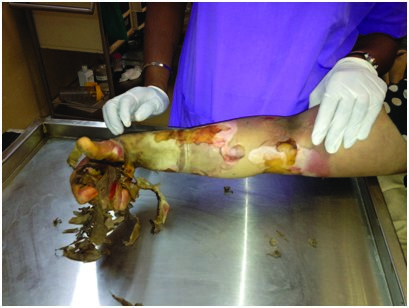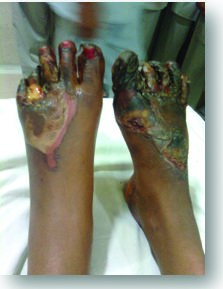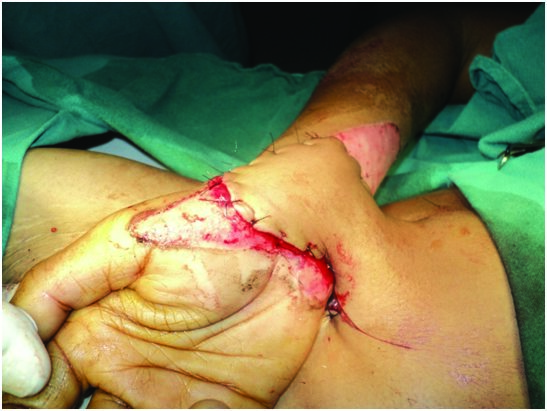Evaluation of Quantum of Disability as Sequelae of Electric Burn Injuries
Ajay Lunawat1, Sanjay M Datey2, Avinash Vishwani3, Rishikant Vashistha4, Vikramaditya Singh5, Tanmay Maheshwari6
1Associate Professor, Department of Surgery, Sri Aurobindo Medical College and PG institute, Indore, Madhya Pradesh, India.
2Professor, Department of Surgery, Sri Aurobindo Medical College and PG institute, Indore, Madhya Pradesh, India.
3Assistant Professor, Department of Surgery, Sri Aurobindo Medical College and PG institute, Indore, Madhya Pradesh, India.
4Assistant Professor, Department of Surgery, Sri Aurobindo Medical College and PG institute, Indore, Madhya Pradesh, India.
5Resident, Department of Surgery, Sri Aurobindo Medical College and PG institute, Indore, Madhya Pradesh, India.
6Resident, Department of Surgery, Sri Aurobindo Medical College and PG institute, Indore, Madhya Pradesh, India.
NAME, ADDRESS, E-MAIL ID OF THE CORRESPONDING AUTHOR: Dr Ajay Lunawat, 46,Bhagwandeen Nagar, Indore. Madhya Pradesh-452001, India.
E-mail: drajay_lunawat@rediffmail.com
Background: All will agree that invention of electricity has changed the world. Today nobody can think of living without an uninterrupted supply. Electricity is definitely a boon to the mankind but this turns into a curse when it becomes a cause of disaster. Electrical burn injuries are the most destructive injuries with a potential of causing significant functional disability and extensive disfigurement in the survivors.
Materials and Methods: We carried out a retrospective observational study on the 110 patients of electric burns admitted to our hospital between January 2007 and October 2014. The aim of the study was to determine the demographic and clinical profile of patients who had sustained electrical burn injury, with a special emphasis on limb loss. Section-2 of Workman's Compensation Act 1923 was used for the calculation of an individual's disability due to amputation. All the data was analysed using method of simple percentages and presented in a tabular form.
Result: Forty eight patients (43.63%) of electric burn belonged to the age group of 21-30 y, with male preponderance (M:F:: 93.6 : 6.4). This shows that the individual affected more often are invariably the breadwinners of the family.Twenty four, out of these 110 patients have undergone one or more than one amputation. Significantly the numbers of upper limb amputations have exceeded any other amputation in this study. Mortality in patients of electrical burns is 6.36% in comparison to mortality of 45.67% in all burn patients.
Conclusion: Loss of upper limb completely reduces the earning capacity of an individual. Future and fortune of the individual's family is jeopardized. Such accidents can be prevented by following safety norms and simple precautions while using the electrical equipment.
Introduction
All will agree that invention of electricity has changed this world. Today nobody can think of living without an uninterrupted electric supply. Electricity, the boon to the mankind turns into a curse, when it is the cause of a disaster. Most of the times the victim is at fault and pays a very heavy penalty by losing either life or a part of his body. Electrical burn injuries are the most destructive injuries with a potential of causing significant functional disability and extensive disfigurement in the survivors. This study is a continuation of previous epidemiological study of 67 cases, “Epidemiology and outcome of electric burns at SAIMS” by the same authors [1]. This observational study was designed to analyse the clinical profile and outcome with a greater emphasis on limb loss in the victims of electrical injuries. We wanted to quantify the loss of life and degree of disability due to electrical burns. Disability can be physical and emotional and therefore very difficult to analyse and quantify. The victims are most commonly young men, who are the sole breadwinners of their families. Impact of loss of the working hand of a young man due to electrical burn can destroy the future of the family. With the enormous economic progress and rapid industrialization in our country, future will see more and more use of electrical equipments. In the days to come we are likely to see more victims of electrical burns with a multiplied problem of life and limb loss in our community. Accidents leading to electrical burn injuries are preventable. Strict implementation of the prescribed safety norms and public awareness about precautions relating to the use of electrical equipment can reduce such accidents.
Materials and Methods
This observational study was conducted from January 2007 to October 2014 in the burn unit of Sri Aurobindo Medical College i6and Postgraduate Institute. The patients of electrical burn injuries admitted in the Burn unit during this period were included in the study. The patients discharged against medical advice (DAMA) were not included. Also, the patients with only electrocution without any electrical burn injury were not included. The study was done by retrieving the case records of 110 patients of electrical burn injuries between January 2007 to October 2014.The case records were analysed and the data was entered on a master chart. Section-2 of Workman's Compensation Act 1923 was used for the calculation of an individual's disability due to amputation. All the data were further analysed by biostatistician using method of simple percentages and presented in a tabular form.
Results
We had a total of 110 patients of electric burn injuries from January 2007 to October 2014. A total of 1237 patients were admitted to the burn unit in this period of seven years and ten months. Electric burn patients were 8.98% of the total admissions in the period of study.Forty eight patients (43.63%) of electric burn belonged to the age group of 21-30 years. This shows that an individual is affected mostly in the middle of his life. Occupational exposure can be attributed as the reason for high incidence in this age group. It was also seen that there was a complete male preponderance (M:F::7:103), in the number of victims of electric burn. Males are more prone to electric burns as they come in contact with electrical equipment due to work related reasons.
[Table/Fig-1] shows the overall mortality during the study period and its comparison with the mortality of electric burns. Fatality in cases of electrical burns occurs at the site of accidents, those who survive the initial brunt of injury and effect of electrocution will reach to the health care provider and survive, although with extensive disfigurement. Mortality in electrical burns is 6.36% in comparison to the overall mortality of 45.67%. In this studyHigh tension line was the cause of injury in 76.36% as most of the victims were involved in accidents related to agricultural activities, work or at the construction sites and factories. Out of the 110 cases, 55.45% of the patients were accidental in nature, whereas remaining 44.54% were occupational hazards [Table/Fig-2].
[Table/Fig-3] indicates the numbers of surgical procedures in the victims of electric burns in this study. Patients have undergone multiple procedures at different times. Debridement/Escharotomy (106) is the commonest procedure which has to be done under anaesthesia. Repeated debridements are needed in cases of electrical injuries as there is progressive necrosis of the tissues. Fasciotomies (22) have an enormous role in salvaging of the limbs after electrical injuries as compartment syndrome is very common. Timely fasciotomy can save a limb from amputation. Skin grafting (30) is mandatory in covering the large granulating surfaces left after debridement. Amputations (42) of limbs form a major group of surgery in the treatment of electrical burn injury. Study also has one patient with fracture dislocation in the cervical spine (C4-5) due to fall and underwent cervical laminectomy.
[Table/Fig-4] highlights the gravity of the problem of tissue loss due to electric burns. Invariable involvement of upper extremities is seen in most of the cases of electric burns. Amputations at the level of forearms (15) and digits (10) are at the top of the list in this study [Table/Fig-5,6,7,8].
Few unfortunate victims have multiple amputations like one patient in this study had amputations of both upper limbs at mid-forearm level and the right lower limb at mid-thigh level. Out of 110 patients, 103 were males, most of them were from 2nd, 3rd, 4th decade of life. One can only imagine the impact of losing the working hand at the prime of his life.
On the basis of the collected data from this study we have tried to estimate the quantum of disability caused by electric burn injuries shown in [Table/Fig-9]. Percentage loss of earning capacity of an individual victim who has undergone an amputation or multiple amputations was calculated by the help of the Workman’s Compensation Act 1923. Total or partial disablement in victims of electrical injuries will throw light on the magnitude of the problem.
Twenty four patients had one or more amputations due to electrical burn injuries in this study. Percentage of disability in the earning capacity of the individual was decided with the help of Workman’s Compensation Act. We found that seven patients (7 out of 110 i.e.6.36%) were totally disabled (100% or more than that) while others were partially disabled. [Table/Fig-10] shows the percentage of disability in earning capacity and the number of patients.
Discussion
Electric burn injury is one of the most destructive injuries seen in a casualty room of any hospital. It is a special type of injury with potential of causing significant functional disability and extensive disfigurement. Electric burns can be caused by high tension and low tension currents. The intensity of the electric burn depends upon the voltage, current flow and resistance offered by the tissue [2]. The damage caused by the electric burn is due to two mechanisms, local generation of heat and direct action of passage of current through the tissues. The heating causes coagulative necrosis of the cells and current causes disruption of cell membrane leading to cell death and tissue loss [3].
Total number of 1237 patients were admitted to our burn unit during the period of study. Out of these 110(8.89%) were due to electric burns. This percentage is similar to the 7.2% incidence of electric burns in a study by Jayesh Sachde et al., [2]. Dega et al., have also mentioned about 665 (6.65%) cases of electric burn out of 10000 admissions of burn between 1996 to 2004 in their study [4].
Maximum patients (43.63%) belonged to the age group between 21 to 30 y. This shows that the people from the most productive period of life are commonly affected. Similar figures are shown in other studies [4].Only 7 out of 110 were females (6.36%). Males are prone to get injured because of occupational exposure. Similar statistics is presented from Shiraz University Hospital of Iran where male female ratio of 95.3 : 4.7% in cases of electric burn was found [5]. Comparison of the rural urban ratio of patients with the developed countries finds that more number of their patients are of urban background [6]. Seven out of 110 (6.36%) patients died of the complications of electric burns in this study. In a series of 311 employees of French electric company, who suffered work related electric burns, 3.2% died [7]. Mortality due to electric burn is not related to the burnt body surface area [3]. Duration of stay in the hospital for the treatment is again not dependent on the percentage of burn area. In our study the average stay was 23.83 days which is comparable to the data of Haddad et al., from King Hussein Medical College of Jordon [8]. Electric burns of the limbs are detrimental to their vascularity. Immediate charring of tissues and delayed damage due to compartment syndrome are the causes of the loss of limbs. The upper limbs of the victims are invariably involved in the accident and make them more vulnerable. Early and adequate fasciotomy is of utmost importance in the salvage of borderline electric burn injury of a limb [9]. In this study 22 fasciotomies were done. We cannot comment, as to what extent these fasciotomies really helped in salvage of the limb because of the lack of objective evidence. Total of forty two amputations were done in 110 patients of electric burns in last seven years and ten months of study, in our hospital. Some patients have undergone more than one amputation. Dega et al., have reported 155 amputations in 665 patients of electric burns (24%) in their study of total 10000 admissions of burn during 1996 to 2004 [4].Tissue loss and limb loss are major problems in survivors of electric burn injuries. We have tried to analyse the effect of these amputations on the life of the victim with the help of the Workman's compensation act of 1923. Newer acts are also in use. Twenty four patients have undergone one or more than one amputations in our study of 110 patients. 100% disability in the earning capacity was seen in seven patients and more than fifty percent was seen in 10 patients. Three of them had less than 30% disability according to the format but in fact it was a total disability to earn as they had lost the digits or thumb of the working hand. Hedawoo et al., concluded in their study of 49 cases of electric burns that 40% became completely disabled. In their study 96% victims had electrical injuries of upper limb [10]. These findings could be the tip of an iceberg as this study was done in a paying hospital; the numbers would be considerably higher if figures from government hospitals are added. Electrical burn injuries are result of an accident and every accident has multiple causative factors. Negligence or lack of knowledge on the part of the user is a very common factor in electric burn injuries.
Comparison of mortality in electrical burns with total admissions of burn.
| Criteria | No. of patients | Mortality | Percentage |
|---|
| All type of Burns | 1237 | 565 | 45.67% |
| Electrical burns
| 110 | 07 | 6.36% |
Distribution of accidental versus work related electric burn injury
| Cause of burn | Number of patients | Percentage |
|---|
| Work related | 49 | 44.54% |
| Accidental
| 61 | 55.45% |
Distribution of surgical procedures performed in victims of electric burn
| S. No. | Surgical Procedure | Number |
|---|
| 1. | Fasciotomy | 22 |
| 2. | Debridement, Escharotomy | 106 |
| 3. | Superficial Skin Grafting | 30 |
| 4. | Amputations | 42 |
| 5. | Flap rotation | 02 |
| 6. | Intercostal catheterisation | 02 |
| 7. | Cervical laminectomy | 01 |
Distribution of site of amputation in victims of electric burn
| LOWER LIMB | Left below knee | 2 |
| Left above knee | 2 |
| Right below knee | 3 |
| Right above knee | 2 |
| UPPER LIMB | Left below elbow | 7 |
| Left above elbow | 1 |
| Right below elbow | 8 |
| Right above elbow | 2 |
| Digits/Thumb | Amputations/disarticulations | 10 |
| Toes | Amputations/disarticulations | 5 |
Right hand and forearm electric burn injury with extensive charring

Electric burn injury leading to gangrene and charring in right and left foot

Left Below elbow amputation stump with flexon contracture at right wrist joint

Groin Flap covering flexor tendons and exposed radial artery of right forearm near wrist joint

Quantum of disability caused by electric burn injury (percentage calculated by workman’s compensation act 1923)
| Patient’s serial no. | Amputations (percentage disability) | Total disability |
|---|
| 5 | Right below elbow (70%) | 100% (160%) |
| Both feet (90%) | |
| 9 | Right forearm (70%) | 70% |
| 11 | Right above knee (80%) | 100% (106%) |
| Left index finger (14%) | |
| Left middle finger (12%) | |
| 15 | Right Forequarter (90%) | 90% |
| 16 | Left forearm (90%) | 100% (104%) |
| Left great toe (14%) | |
| 27 | Right Above knee(100%) | 100% (270%) |
| Left above knee (100%) | |
| Left below elbow (70%) | |
| 33 | Right little finger (3%) | 31% |
| Left index finger (14%) | |
| 4 toes of Right foot (9%) | |
| 4 toes of left foot (5%) | |
| 36 | Amputation of both forearms (100%) | 100% |
| 45 | Left upper limb (below elbow) 70% | 89% |
| Left great toe 14% | |
| Left 2nd, 3rd toes 5% | |
| 49 | Right upper limb(below elbow) 70% | 70% |
| 53 | Left above knee | 100% |
| Right above elbow | |
| 63. | Right below elbow | 100% |
| Right below knee | |
| 64 | left ring finger | 7% |
| left middle finger | |
| 68 | Left above elbow | 70% |
| 70 | Both upper limbs(below elbow) 100% | 100% (170%) |
| Right below knee 70% | |
| 73 | Right index finger 14% | 26% |
| Right middle finger 12% | |
| 74 | Right index finger 14% | 26% |
| Right middle finger 12% | |
| 79 | left upper limb (below elbow) | 70% |
| 85 | Right upper limb(below elbow) | 70% |
| 89 | Right index finger | 14% |
| 95 | Right lower limb (Below knee) | 50% |
| 97 | Left 2nd and 3rd digits (12+7%) | 19% |
| 103 | Left below knee | 70% |
| 104 | Left thumb | 30% |
Distribution of electric burn patients according to percentage of disability
| Range of percentage of disability | Number of patients |
|---|
| 1 to 24 % | 03 |
| 25to 49% | 04 |
| 50 to 74% | 07 |
| 75 to 99% | 03 |
| 100 % and above | 07 |
| Total | 24 |
Conclusion
Most of accidents leading to electric burn injuries are preventable by observing very simple precautions. Safety measures and precautions in the use of electrical equipment can be imbibed in schools itself as a part of primary education. Governmental agencies have to ensure that the rules and regulations about electric supply and use are strictly followed. All these measures cannot stop but will definitely help in reducing the menace of electric burn.
[1]. Lunawat Ajay, Datey SM, Vishwani Avinash, Khare Yashasvi, Ranjan Vikrant, Epidemiology and Outcome of Electric Burns at SAIMS, A Tertiary Care Centre of Central India Journal of Evolution of Medical and Dental Sciences 2013 2(12):1761-70. [Google Scholar]
[2]. Sachde Jayesh, Shaikh MF, Suri Manav, Kapadia Kinnar, Agarwal Sumit, Electric Burn: A two year study Indian Journal of Burns 2008 16(1):19-23. [Google Scholar]
[3]. RC Lee, Injury by electrical force: Pathophysiology, manifestation and therapy Curr Probl Surg 1997 34(4):677-764. [Google Scholar]
[4]. S Dega, SG Ganeswar, PR Rao, P Ramani, DM Krishna, Electrical Burn Injuries. Some Unusual Clinical Situations and Management Burns 2007 33:653-65. [Google Scholar]
[5]. Mohammadi Al Akbar, Amini Masoud, Mehrabni Davood, Kiani Zohreh, Seddigh Azam, A Survey of 30 months of Electric Burns in Shiraz University of Medical Sciences Burn Hospital Burns 2008 34:111-13. [Google Scholar]
[6]. AE Handschin, S Vetter, FJ Jung, M Guggenheim, W Kunzi, P Giovanoli, A case matched controlled study of high voltage electrical injuries vs thermal injuries J Burn Care Res 2009 30(3):400-07. [Google Scholar]
[7]. A Piotrowski, AM Fillet, P Perez, P Walkowiak, D Simon, MJ Corniere, Outcome of occupational electrical injuries among French electric company workers: A retrospective report of 311 cases,1996-2005 Burns 2014 40(3):480-88. [Google Scholar]
[8]. SY Haddad, Electrical burn-A four year study Annals of Burn and Fire disasters 2008 21(2):78-80. [Google Scholar]
[9]. YY Hsueh, LL Chen, SC Pan, Analysis of factors influencing limb amputations in high voltage electrically injured patients Burns 2011 37(4):673-77. [Google Scholar]
[10]. Hedawoo JB, Ali A, Electric burns and disability Journal of the Indian Medical Association 2010 108(1):84-87. [Google Scholar]